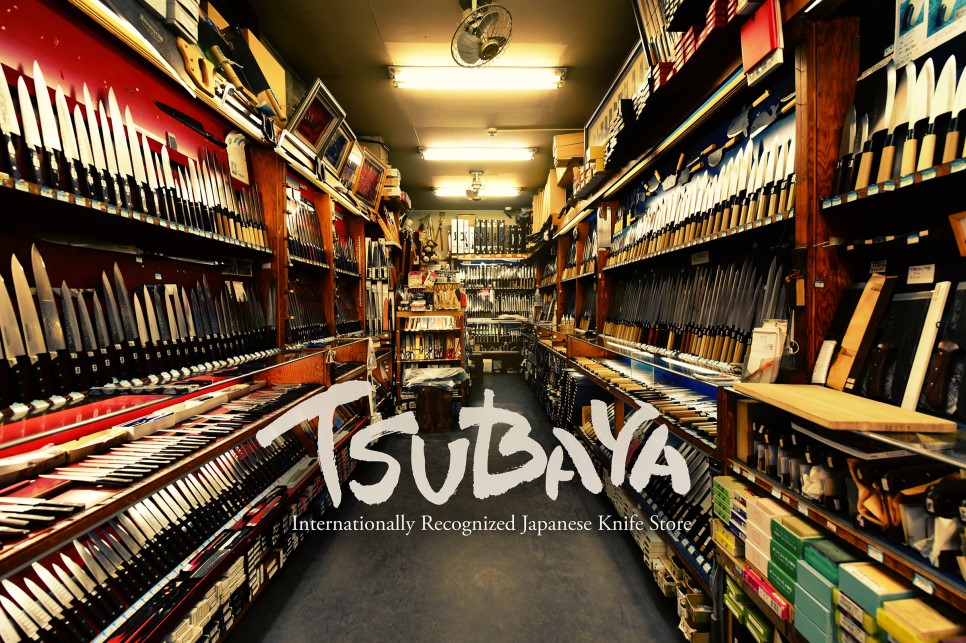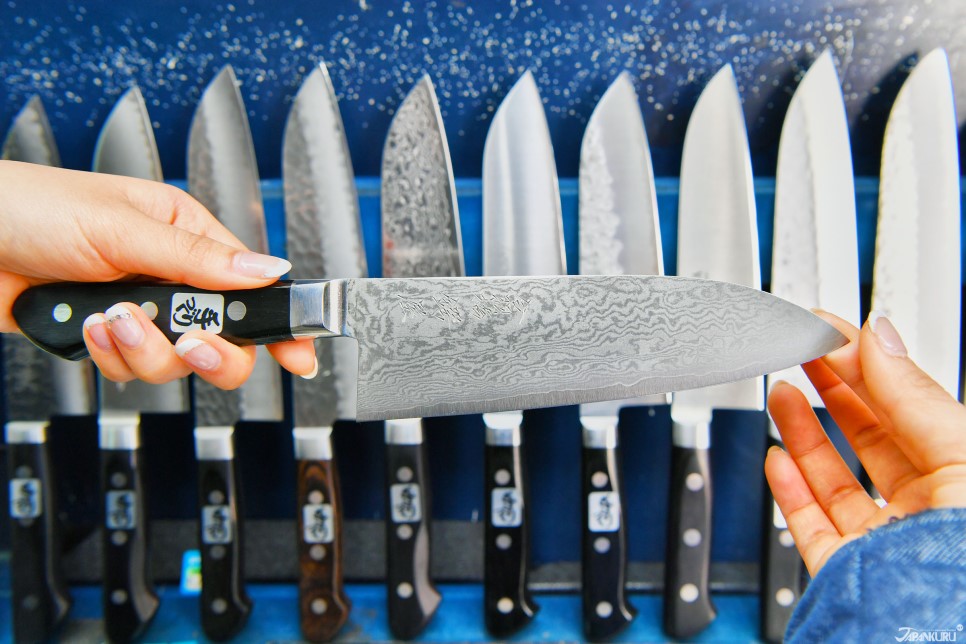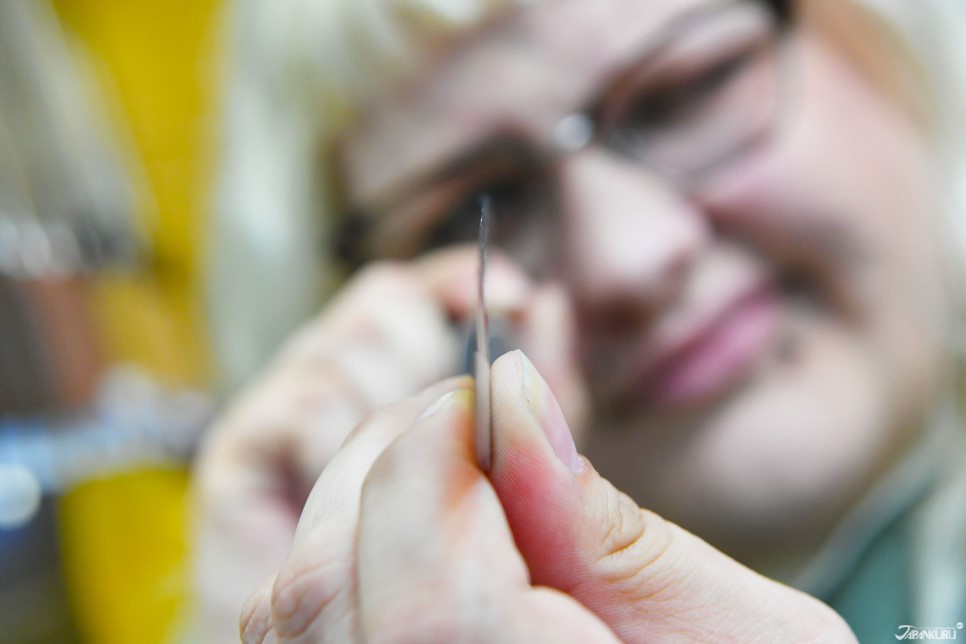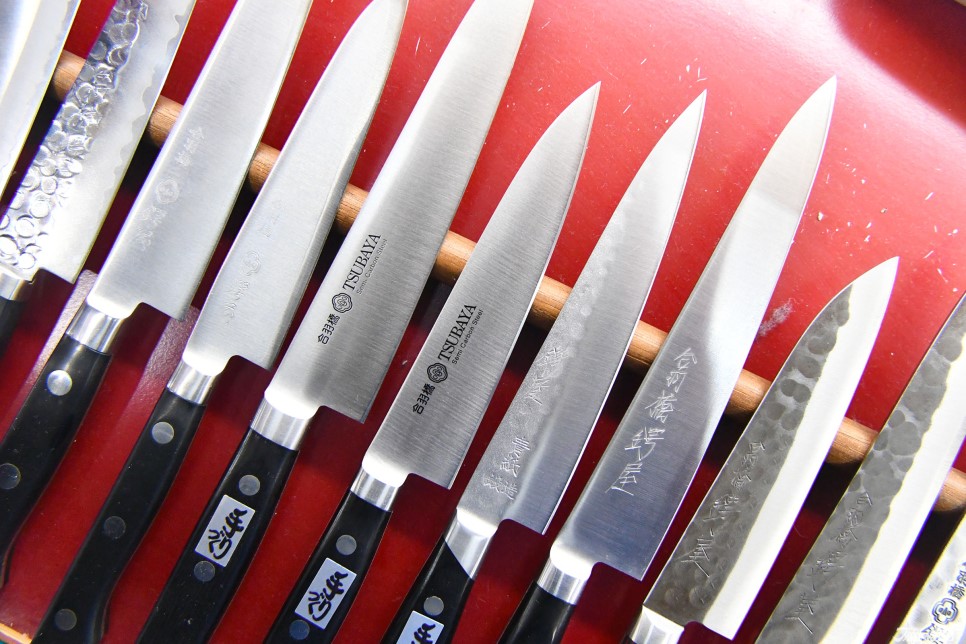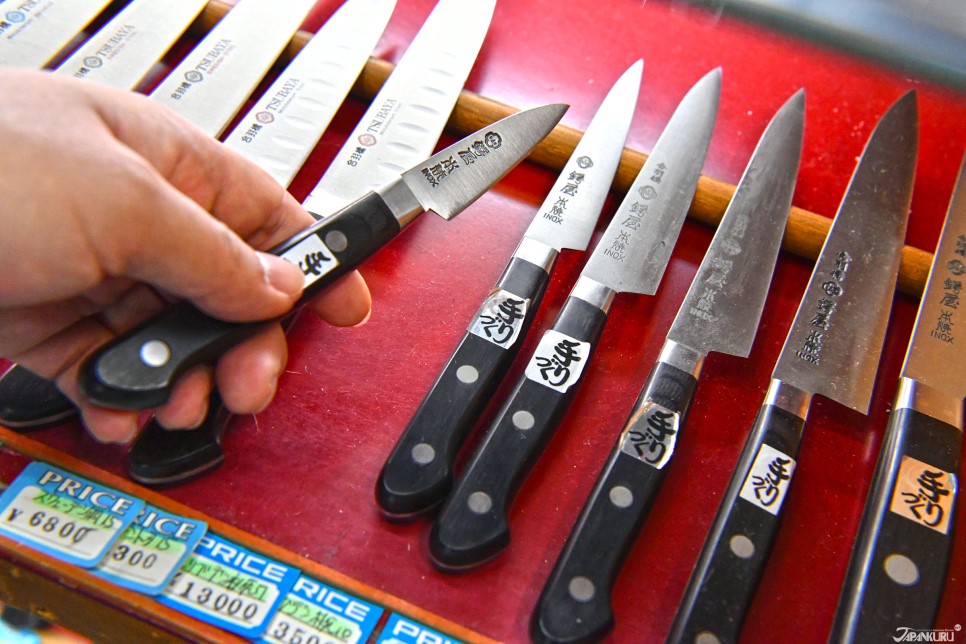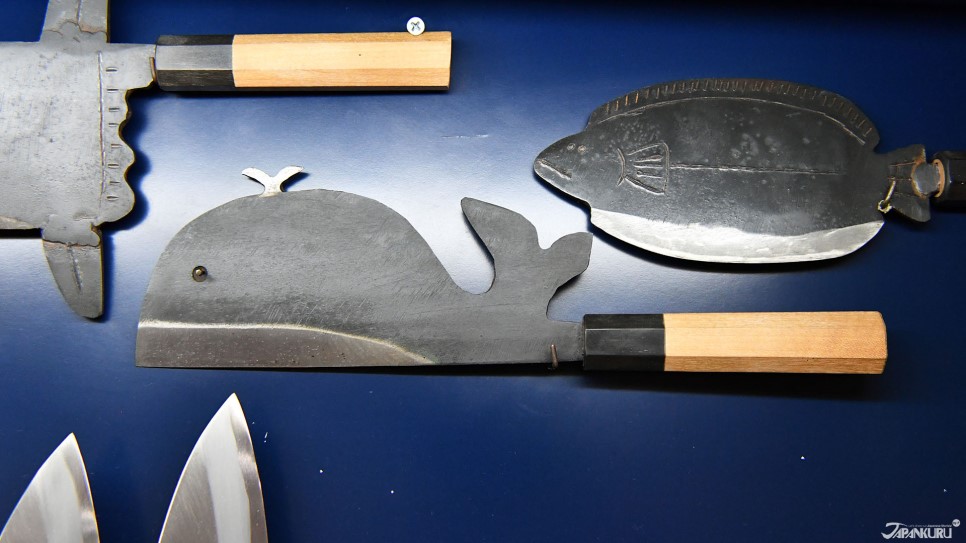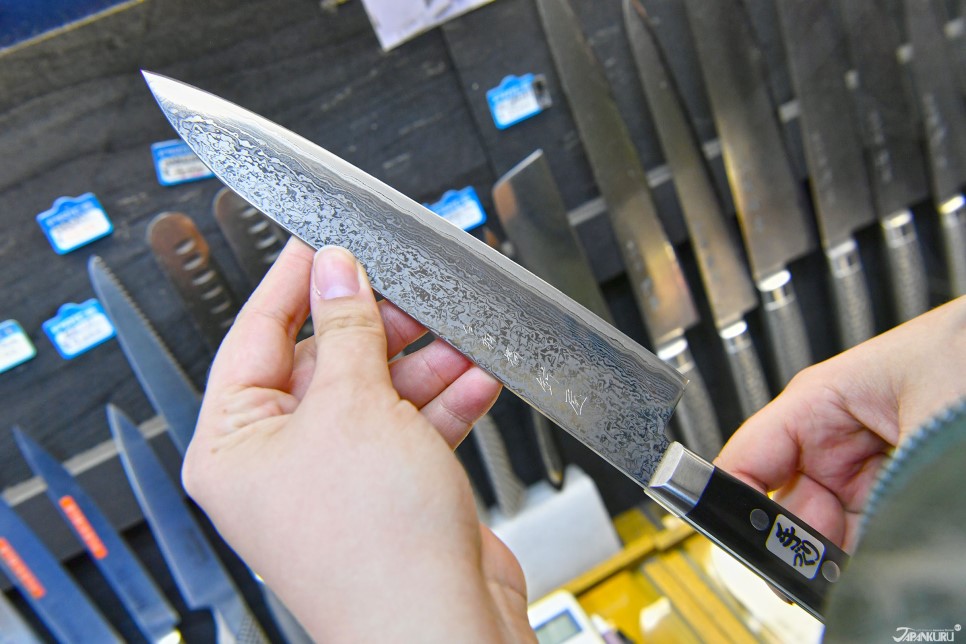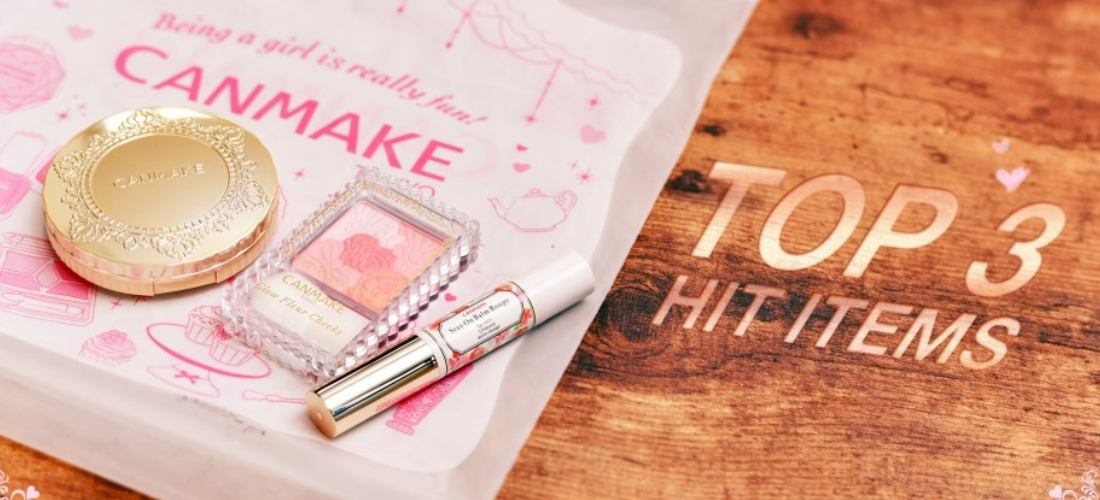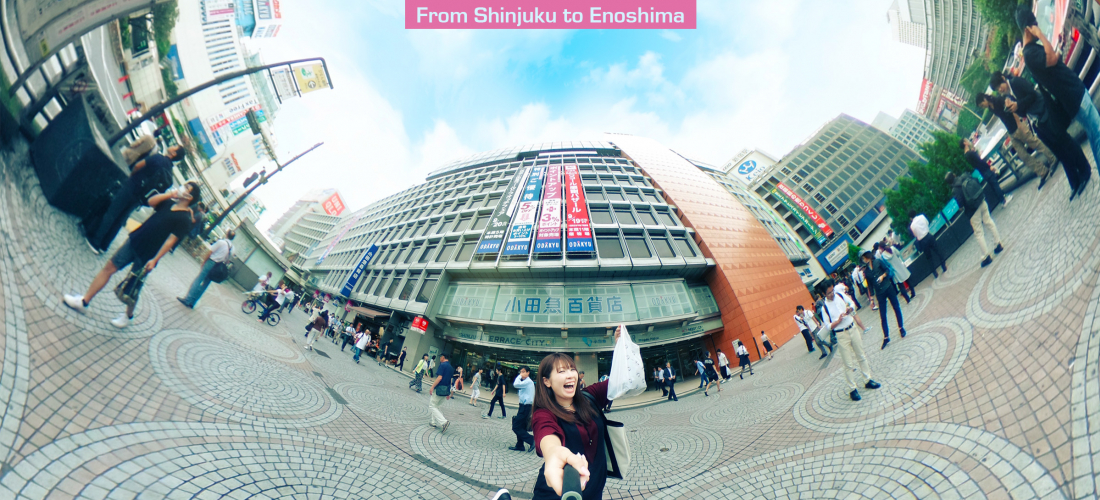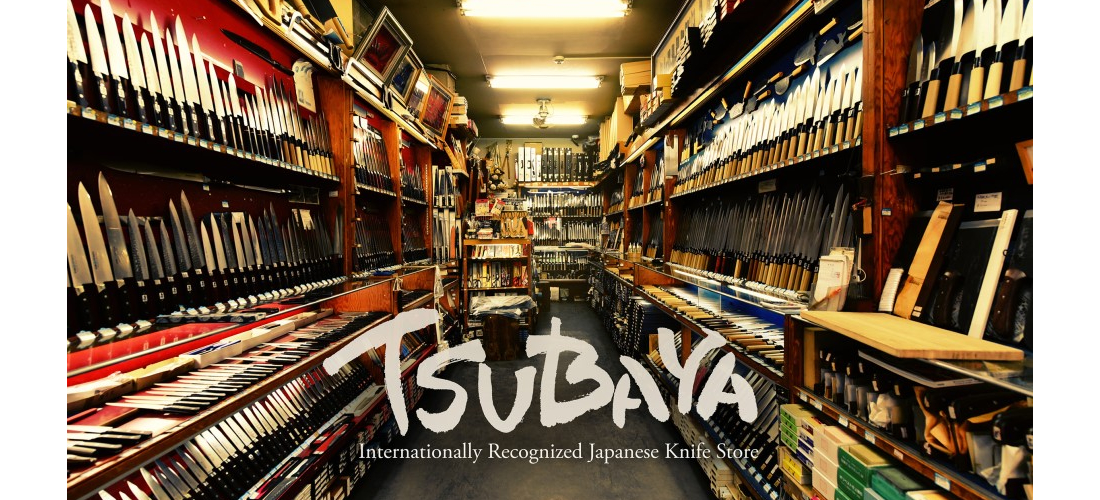
CONTENTS
ここは浅草から程近いかっぱ橋にある包丁屋さん!牛刀、柳刃、出刃包丁、筋引きなどの和包丁からペティナイフやブレッドナイフなどの洋包丁まで、専門性の高いものから一般的に見かけるものまで、包丁を幅広く取り扱う日本の包丁専門店つば屋へようこそ!
A Japanese Cooking Knife Specialty Store Known Around the World
Japanese knives are famous for their high quality, and so have become a popular item for foreign visitors to seek out during their trips. So we decided to dedicate an article to kitchen knives, including some useful information for those, professional chefs or not, looking to buy some knives during their trip to Japan.
Buyers from all over the world flock to the Kappabashi area of Asakusa, Tokyo, to purchase various kitchen and restaurant gear. Right in the middle of this is a store called Tsubaya, which specializes in kitchen knives made by Japanese craftsmen, and is perfect for anyone wondering where they can browse a great selection. This store has even made it onto TV in Japan!
Japan’s Largest Cookware & Kitchenware Shopping Street: Kappabashi (かっぱ橋)
If you're looking for Japanese cookware and kitchenware, or things you never even knew you needed, Kappabashi is your place. Which is why Tsubaya is located there!
CUTLERY TSUBAYA (包丁専門つば屋)🗡
Address: 3-7-2, Nishi-Asakusa, Taito-ku, Tokyo
Access: 7 min. walk from Tawaramachi (田原町駅) on the Tokyo Metro Ginza Line OR 3 min. walk from TX Asakusa Station on the TSUKUBA EXPRESS
Phone: 03-3845-2005
E-Mail: info@tsubaya.co.jp
Official Website
Google Maps
1,000 Knives You Can Handle and Try Out
When you enter the store, you might feel like you've entered a museum of knives. The walls are covered with more than 1,000 cooking knives of all kinds. It's not really all that different from a museum collection— there are a lot of knives!
Knives Classified According to their Applications
Since we're no cooking experts and don't know what makes each of the 1,000+ knives unique or special, we asked them to explain a few of the different kinds that Tsubaya has for sale.
We started with the most all-purpose kinds! These "universal knives" are about 15 to 20 cm long, and are what you often see in a typical home kitchen. These knives are some of the most popular items among Tsubaya's stock, since they're the most basic! They're generally divided into two varieties: Santoku & Gyuto knives.
Santoku (三徳)
Japanese-Style Universal Knives
The "sanko universal knife" is the most widely used knife among the many everyday knives. That means it will work well when cutting just about any food, including meat, fish, and vegetables.
The blade is made in a ratio of 5: 5, and it can cut at any angle without difficulty.
Gyuto (牛刀)
Western-Style Universal Knives
The "Kyūto Kotoku knife" is a kitchen knife widely used in Western countries, and is used mainly for cutting meat.
If you compare it to a santoku knife, you'll notice that it's longer in length and a fair amount narrower. It also has a point where the cross section of the knife edge is shifted by a ratio of 7: 3 or 8: 2, making it a good knife for cutting through hunks of meat, or tendons.
As a universal knife, it can certainly be used for all sorts of things, including vegetables or fish. But it's an especially good choice for those who cut through a lot of meat!
Bread Knives
Tsubaya sells a variety of bread knives as well, even if they're less of a Japanese tradition. Thanks to their cross sections, and their longer ~30 cm lengths, the knives are able to cut further without going back and forth too many times. This helps preserve the shape of the bread, instead of crushing it with too much pressure.
With more Japanese people baking in their homes in recent years, bread knives have become a popular item!
Petty Knives
These little knives originate from Japan, and are usually about 13 cm long. They're great for cutting fruit, and are even frequently used at patisseries! Since they're not particularly common, many patissiers come looking for them.
Unique Knives Only Available at Tsubaya
Fun and Creative Knives
This knife is packed with extremely practical knives, long blades, short blades, they can cut whatever food you throw at them. But that's not all they have!
Knives shaped like whales and blowfish are just some of the more silly options on display. A Chinese customer apparently once ordered a turtle-shaped knife!
Knives Just for Preparing Eel
This particular variety of knife is made specifically for preparing eel! The top of the blade has what looks like a hammer, which is used to hammer the large nail that is used to pin down the eel. They are slippery!
Make it Unique with a Custom Engraving!
If you want to make your knife truly the only one like it in the whole world, you can try out their engraving service. We tried it out by getting our friend's name engraved in kanji (Chinese characters.) Whatever message you want written onto your knife for the rest of its life, they use a dedicated machine at the back of the store to do it immediately, so you don't have to come back to pick it up!
Q & A for First-Time Visitors
Q. On my first visit, what should I buy?
A. We recommend a universal knife, or a petty knife. It's easier for beginner knife-users to use an all-purpose knife, especially since it can be used in the preparation of all kinds of ingredients. If you have a budget closer to 20,000 yen, we recommend purchasing a universal knife and a petty knife together, giving you more variety in knife size.
In addition, we recommend the "yanagiba" (柳刃), which is great for cutting raw fish!
Q. What's the difference between a wooden handle and a plastic handle?
A. The differences lie in both design and durability. Wooden handles have a strong sense of Japanese design, making them appealing to Western customers. Wood is easily discolored, so most Japanese customers prefer plastic handles. (All handles are replaceable, however.)
Q. How should I sharpen my knife?
A. The metal rods you often see in movies are kind of like first-aid, they're a quick fix when you want to use the knife immediately. For thorough sharpening, you have to use a sharpening stone, or togiishi (研ぎ石).
Q. Aren't all the knives the same, aside from size?
A. Aside from the more obvious size differences, the knives also vary in material and durability. They might all look similar at first glance, but the ratios involved in the blades, handles, and different parts' sizes are important. Some are also extra high quality!
For example, stainless steel doesn't have the same cutting force as pure iron, but it doesn't rust. So it's much easier to maintain.
Still Feeling Unsure About Japanese Knives?
Japanese cuisine is now popular around the world, and the huge variety of knives offered by Tsubaya includes a number that are suited specifically for preparing Japanese delicacies. These knives are perfect for any budding chefs you may know! And if you walk in and feel a little overwhelmed, don't worry! There are English-speaking staff, and they are happy to spend some time teaching you about the great variety of knives available, and helping you find the perfect knife to take home with you. (Just don't forget to put your precious new kitchen knife in your checked baggage! You don't want it getting confiscated by security.)
3-7-2, Nishi-Asakusa, Taito-ku, Tokyo
7 min walk from Tawaramachi (田原町駅) on the Tokyo Metro Ginza Line OR
3 min walk from TX Asakusa Station on the TSUKUBA EXPRESS
Phone: 03-3845-2005
E-Mail: info@tsubaya.co.jp
Google Maps
(If you're looking for a place to stay nearby, try here!)
Be sure to look out for more exciting articles every day at JAPANKURU! 🐶
Or add us on Instagram and Facebook to share your pictures of Japan. 💖🗾
⇩Learn More About Tsubaya in Our Video Below⇩
Details
NAME:CUTLERY TSUBAYA (包丁専門つば屋)
MAP
ACCESS:Asakusa Station
PROFILE
Follow us @Japankuru on Facebook, Instagram, and Twitter!
COMMENT
FEATURED MEDIA
VIEW MORE
・Accommodations for Odaiba Sightseers: Mitsui Garden Hotel Toyosu PREMIER ・住宿推薦 三井花園飯店 豐洲普米爾 ・오다이바 관광 맞춤 숙소: 미츠이 가든 호텔 토요스 프리미어 ・ค้างคืนที่ Mitsui Garden Hotel Toyosu Premier โรงแรมสำหรับผู้มาเยือน Odaiba #japankuru #odaiba #tokyo #tokyotrip #japantrip #japantravel #mitsuigardenhotel #mitsuigardenhoteltoyosupremier #tokyohotel #odaibahotel #toyosu #tokyoview #tokyobay #rainbowbridge #미츠이가든호텔토요스프리미어 #오다이바 #오다이바맛집 #오다이바건담 #오다이바해변공원 #오다이바야경 #오다이바온천

Nagano Prefecture is famous for delicious soba noodles, and in the city of Ueda, you can learn from the experts! Local aunties run this cooking class, teaching you everything you need to know to make your own delicious plate of soba noodles entirely from scratch. #japankuru #soba #sobanoodles #japanesefood #travelexperience #japan #japantrip #ueda #nagano #japaneseculture #japanexperience #daytrip #daytour #cookingclass #japanesecookingclass #上田市 #そば作り #소바체험 #우에다시 #나가노여행 #일본소바

Kuramae Shrine is known for its early-blooming cherry blossoms and its gorgeous golden mimosa blooms, making it a great sakura spot for travelers arriving in Tokyo a little early for the main cherry blossom season. It’s also tucked away in a neighborhood packed with trendy cafes and coffee shops. Kuramae is a lovely place to spend the day. 🌸☕️ ・ #japankuru #kuramaeshrine #kuramae #tokyo #tokyotrip #cherryblossom #cherryblossoms #mimosa #tokyocherry #花見 #蔵前神社 #ミモザ #桜 #東京 #Japan #日本 #일본 #Japon #ญี่ปุ่น #Japão #Japón #япония #japantravel #日本旅行 #日本旅遊 #일본여행 #japan_of_insta #japantrip #traveljapan

Local Japanese Favorites at the Okinawa Don Quijote ② Ohta’s Isan, the digestive aid of the Japanese people ・ ・ 2024唐吉訶德不可不知的好物推薦② 日本國民消化小幫手:太田胃散 ・ ・ 오키나와 돈키호테 숨은 꿀템2. 일본 국민 소화제! 오타이산 #japankuru #okinawa #donki #沖縄 #오키나와 #오키나와여행 #오키나와돈키호테 #일본쇼핑리스트 #오타이산 #일본소화제 #太田胃酸 #ohtasisan

Happy Valentine's Day from the Japankuru team! May your day be full of sweet chocolates and sweet nothings. 💕 Or, if you're like a rising number of women in Japan, take the opportunity to treat yourself! 🍫💝💆 • Find out more at Japankuru.com! (Link in bio.) • #japankuru #valentinesday #valentineschocolate #japanesechocolate #japaneseculture #バレンタイン #バレンタインチョコ #メリーチョコレート #Japan #日本 #일본 #Japon #ญี่ปุ่น #Japão #япония #japantravel #日本旅行 #日本旅遊 #일본여행 #japan_of_insta #japantrip #traveljapan #japan🇯🇵 #japanlife #igerstokyo #explorejapan #japanfocus #enjoyjapan #japantravelphoto

Japankuru Coupon: BEAMS fashion, accessories, lifestyle goods, and more! BEAMS 5% Discount Coupon ▶︎ Validity Dates: February 1 ~ February 29, 2024 ▶︎ Discount: 5% off all products in-store ▶︎ Usable At: BEAMS stores throughout Japan (all stores except BEAMS JAPAN Izumo and BEAMS JAPAN Nikko) ▶︎ Details: Please present this coupon page before payment to receive your discount! This coupon is also valid in combination with tax-free discounts/refunds for foreign tourists. (Tax-free shopping is only available at some BEAMS locations.) Some products may not be eligible for discount. ・ ・ ・ BEAMS - JAPANKURU優惠折扣券 BEAMS 2024年2月限定特別優惠券 店內全部商品95折 ▶︎使用期間:2024/2/1到2024/2/29 ▶︎使用範圍:日本全國店舖 ▶︎使用方法:結帳時請務必事先向店員出示本優惠券,若未出示本優惠券恕無法享有本優惠。本優惠券可搭配免稅優惠一併使用,但不排除特定門市無法使用本優惠券。此外,不排除特定商品不適用本優惠券。 ・ ・ ・ 「빔즈(BEAMS) x 재팬쿠루(JAPANKURU)」스페셜 할인 쿠폰 빔즈(BEAMS) 5% 할인 쿠폰 ▶유효기간: 2024년 2월 1일 ~ 2월 29일(한 달 동안) ▶︎할인율: 매장 내 전 상품 “5% 할인" ▶︎해당 매장: 일본 전국 빔즈 (BEAMS) 매장 (BEAMS JAPAN이즈모、BEAMS JAPAN닛코는 쿠폰 할인 대상 제외 점포입니다) ▶︎상세 내용: 결제 전 본 쿠폰 페이지를 제시하면 정가대비 5% 할인된 금액에 구매하실 수 있습니다! 본 쿠폰은 외국인 관광객들을 대상으로 하고 있으므로 면세 혜택(빔즈 일부 매장)과 별도로 추가 할인이 가능합니다. (일부 매장 및 제품은 대상에서 제외될 수 있습니다.) #japankuru #beams #beamsjapan #beamsginza #coupon #재팬쿠루 #빔즈재팬 #빔즈 #일본여행 #일본쇼핑 #일본쇼핑리스트 #銀座 #東京 #tokyoshopping #japankurucoupon

